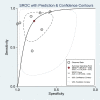Interferon gamma release assays for diagnosis of osteoarticular tuberculosis: A systematic review and meta-analysis
- PMID: 35771875
- PMCID: PMC9246147
- DOI: 10.1371/journal.pone.0269234
Interferon gamma release assays for diagnosis of osteoarticular tuberculosis: A systematic review and meta-analysis
Abstract
Background: Although the Interferon Gamma Release Assays (IGRA) is often used to identify latent tuberculosis, it also plays a crucial role in diagnosing active extrapulmonary tuberculosis. Some studies have assessed the use of IGRA as a biomarker for osteoarticular tuberculosis (OATB), which is elevated following TB infection. Still, conclusive results about its effectiveness have not been reported.
Method: We searched PubMed, Embase, and Cochran databases. We obtained literature related to the diagnosis of OATB by IGRA, and the retrieval period was from the establishment of the database to June 2021. The bivariate random effect model was used to summarize the sensitivity, specificity, and accuracy of other indicators in diagnosing OATB by IGRA, and the forest plot and receiver operating characteristic (ROC) curve were used for testing.
Results: We included seven studies involving 643 subjects in diagnosing OATB by IGRA. The comprehensive sensitivity and specificity were 0.84 (95% CI, 0.70-0.92) and 0.78 (95% CI, 0.66-0.87), respectively. The area under the curve (AUC) was 0.87.
Conclusion: In blood samples, the diagnostic accuracy of IGRAS is poor in patients with suspected OAT. We conclude that IGRA may not be appropriate for patients with OATB.
Conflict of interest statement
The authors declare that they have no competing interests.
Figures





Similar articles
-
Mycobacterial heparin-binding hemagglutinin (HBHA)-induced interferon-γ release assay (IGRA) for discrimination of latent and active tuberculosis: A systematic review and meta-analysis.PLoS One. 2021 Jul 16;16(7):e0254571. doi: 10.1371/journal.pone.0254571. eCollection 2021. PLoS One. 2021. PMID: 34270559 Free PMC article.
-
Accuracy of interferon-γ-induced protein 10 for diagnosing latent tuberculosis infection: a systematic review and meta-analysis.Clin Microbiol Infect. 2019 Jun;25(6):667-672. doi: 10.1016/j.cmi.2018.12.006. Epub 2018 Dec 14. Clin Microbiol Infect. 2019. PMID: 30553864
-
Contribution of a heparin-binding haemagglutinin interferon-gamma release assay to the detection of Mycobacterium tuberculosis infection in HIV-infected patients: comparison with the tuberculin skin test and the QuantiFERON-TB Gold In-tube.BMC Infect Dis. 2015 Feb 14;15:59. doi: 10.1186/s12879-015-0796-0. BMC Infect Dis. 2015. PMID: 25886172 Free PMC article.
-
Interferon-γ release assay as a sensitive diagnostic tool of latent tuberculosis infection in patients with HIV: a cross-sectional study.BMC Infect Dis. 2018 Nov 19;18(1):585. doi: 10.1186/s12879-018-3508-8. BMC Infect Dis. 2018. PMID: 30453903 Free PMC article.
-
A Feasibility Study for Diagnosis of Latent Tuberculosis Infection Using an IGRA Point-of-Care Platform in South Korea.Yonsei Med J. 2019 Apr;60(4):375-380. doi: 10.3349/ymj.2019.60.4.375. Yonsei Med J. 2019. PMID: 30900424 Free PMC article.
Cited by
-
How to diagnose TB in migrants? A systematic review of reviews and decision tree analytical modelling exercise to evaluate properties for single and combined tuberculosis screening tests.Eur Respir J. 2025 Jul 24;66(1):2402000. doi: 10.1183/13993003.02000-2024. Print 2025 Jul. Eur Respir J. 2025. PMID: 40268506 Free PMC article.
-
Tuberculous arthritis of native joints - a systematic review and European Bone and Joint Infection Society workgroup report.J Bone Jt Infect. 2023 Aug 28;8(4):189-207. doi: 10.5194/jbji-8-189-2023. eCollection 2023. J Bone Jt Infect. 2023. PMID: 37780528 Free PMC article.
-
Early detection of tuberculosis: a systematic review.Pneumonia (Nathan). 2024 Jul 5;16(1):11. doi: 10.1186/s41479-024-00133-z. Pneumonia (Nathan). 2024. PMID: 38965640 Free PMC article. Review.
-
Decoding the hidden realm: Molecular pioneering unravelling osteoarticular tuberculosis diagnosis.J Clin Orthop Trauma. 2024 Sep 12;56:102538. doi: 10.1016/j.jcot.2024.102538. eCollection 2024 Sep. J Clin Orthop Trauma. 2024. PMID: 39318541
References
Publication types
MeSH terms
LinkOut - more resources
Full Text Sources

